Many barrels - many bullets
Volley from Europe
The first samples of such systems appeared more than five centuries ago. But loading from the muzzle, without detracting from the density of fire, had a bad effect on the overall rate of fire. As a result, the overall effectiveness of the weapon was not much higher than that of individual shooters. The idea with several trunks had to be postponed for the time being.
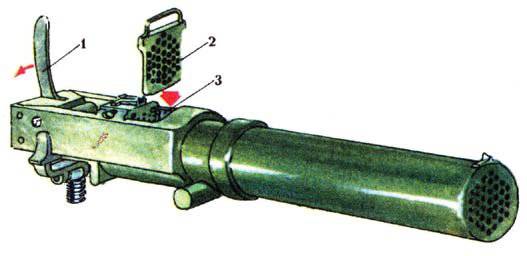
The time of multi-barrel systems came only in the middle of the 1851th century. In 1859, the Belgian Montigny made a gun with a block of gun barrels loaded from the breech. The recently appeared unitary cartridges also turned out to be very useful. They were easy to load into special clips that looked like a metal plate with holes. The clip was inserted into the breech of the installation and all the cartridges were fired at the same time. Due to the clip, in comparison with the guns of the XV century, the rate of fire has increased significantly. Already in XNUMX, this model was adopted in France under the name "mitralise". In Russia, this word was translated literally - gambler. However, the bullets flew in a small "flock" and the area of damage was low. It happened that one enemy soldier managed to "catch" several pieces of lead at once. Dispersion reached acceptable values only at very large distances, where the energy of the bullets was reduced to unacceptable values. Another problem with the first mitrailleuses was the simultaneous firing of all barrels. On later models, ammunition was saved by firing several rows of barrels in turn. But even with this innovation, the card players did not receive much fame. The fact is that the French did not bother to develop tactics for their use, and simply put them on the battlefield in rows, almost “anywhere”, and not in potentially dangerous areas.
barrel organ of death
Overseas, in the United States of America, at that time, the doctor R. J. Gatling was working on his brainchild. He also decided to use several barrels, but not for firing in volleys. If a cartridge has to be loaded into the barrel, then it fires, and then the cartridge case must be ejected ... Why not make several barrels, each of which is loaded and ejects the cartridge case while others are firing? That's what Gatling thought. The result of his inventions was an easel apparatus with six barrels. The shooter, like on a barrel organ, twisted the handle in the breech of the weapon, setting the block of barrels in motion. Cartridges from a box magazine at the top of the gun were fed under their own weight into the chambers. For each turn of the block, each individual barrel managed to receive a cartridge, shoot and eject the sleeve. The extraction of spent cartridges, it is worth noting, was also carried out due to gravity. It is necessary to make a reservation: the very idea of a rotating block of the barrel was not new, by that time multiply-charged pepperbox-type revolvers already existed. The main merit of Gatling is the cartridge supply system and the distribution of the loading-shot-extraction cycle during the rotation of the block.
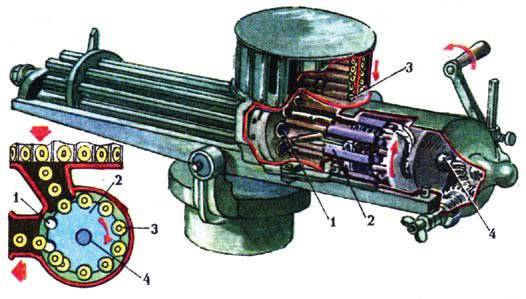
The original Gatling gun was patented in 1862 and adopted by the Army of the North in 1866. The first models could fire up to 200 rounds per minute. Later, using gears, it was possible to bring the rate of fire to almost a thousand shots. Since the source of energy was external (for the then Gatling gun - a person), the machine gun fired as long as there were cartridges in the magazine, until a misfire occurred or a cartridge jammed in the barrel. Later, an automatic weapon with an external drive would be called a mechanized automatic. But before this name there were still several decades.
At the end of the 2500th century, attempts were made to “wean” a person from turning the handle and replace him with an electric motor. But at that time, the electrical components had such dimensions that no 3000-XNUMX rounds per minute, to which they accelerated the machine gun, could give them a start in life. In addition, the notorious H. Maxim has already launched his much more mobile machine gun on the market, the maximum rate of fire of which was at the level of the first Gatling devices. Gradually, multi-barreled machine guns were removed from service, and then they were completely forgotten.
One hundred years after Dr. Gatling
In the middle of the XNUMXth century, weapons with a high rate of fire were again required. In particular, it required aviation and air defense: they now had to fight with such fast targets that the rate of fire even at one and a half thousand could not be enough. It was possible, of course, to use developments on machine guns like UltraShKAS (about 3000 rounds per minute), but its caliber was insufficient, and it was not profitable to rework the design for other cartridges. Another factor that prevented designers from overclocking the classic scheme was in temperatures. One barrel heats up during continuous firing, and, having gained a certain temperature, it can collapse. Of course, before that, ballistics will drastically deteriorate due to deformation. This is where the Gatling system came in handy. There was already experience with overclocking it to two or three thousand shots, which, together with new alloys for barrels, looked encouraging.
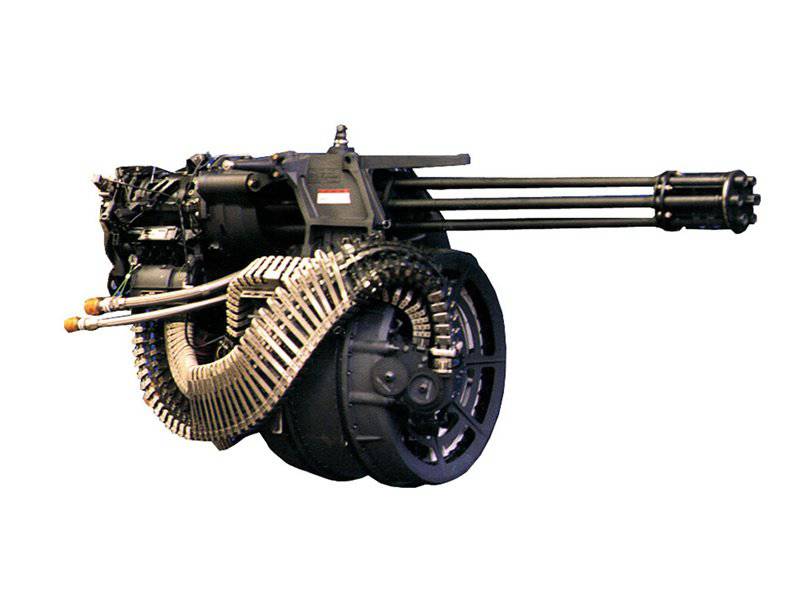
Experiments were going on in many countries, but the first serial model of the "new" Gatling guns was the American M61 Vulcan. Designed in 1949, it had six 20mm barrels with a hydraulic block drive. The Vulkan has two firing modes - 4 and 6 thousand rounds per minute. The design allowed more, but there were concerns about the stable behavior of the cartridge belt links. Therefore, the new modification of the M61A1 gun received generally linkless ammunition. Even six thousand shots were enough to make the Vulcan cannon the standard weapon for American fighters for many years to come.
Later in the United States, several more samples of Gatling Guns will be created under a different cartridge and with a different drive. The smallest caliber was in an experimental machine gun with an electric drive XM214 Microgun of the 70s - 5,56 mm; the largest - also in the experimental T249 Vigilante of the 56th year - 37 mm.
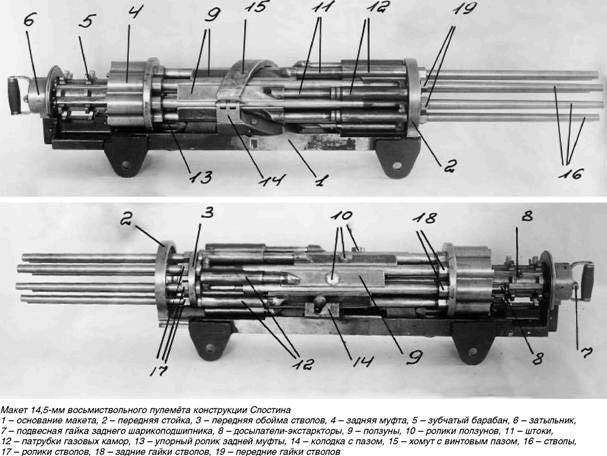
In the Soviet Union, too, they did not ignore weapons with a rotating block of barrels. Back in 1939 I.I. Slostin made his eight-barreled 7,62 mm machine gun. For a number of reasons (heavy weight and damp design), he did not go into series, but some developments were used later. Work on multi-barrel systems was resumed in the early 60s, when the fleet ordered a six-barreled gun of 30 mm caliber from gunsmiths. Thanks to the Tula KBP and designers V.P. Gryazev and A.G. Shipunov, the sailors received the AK-630 ship anti-aircraft gun, a little later, the GSH-6-30 aircraft gun will be created on its basis. This gun had a rate of fire of 4-5 thousand rds / min, which, together with the caliber, was more than enough to destroy most of the targets that fighters work with. Almost simultaneously with the 30 mm cannon, a smaller caliber gun GSh-6-23 (23 mm) was created. It was already originally an aircraft gun with a rate of fire of up to nine thousand shots. Both Tula weapons, GSh-6-30 and GSh-6-23, have a gas engine for rotating the barrel block, but differ in the starter: on the first gun it is pneumatic, on the second it is pyrotechnic.
In the late 60s, work began on multi-barreled machine guns. These were four-barreled GShG (Tula KBP) chambered for 7,62x54R, giving up to 6 thousand rounds per minute and YakB-12.7 (TsKIB, designers P.G. Yakushev and B.A. Borzov) chambered for 12,7x108 mm, with rate of fire 4-4,5 thousand rds / min. Both machine guns were intended for use on helicopters. In particular, the YakB-12,7 was installed on a number of modifications of the Mi-24 in a mobile unit.
Several interesting rumors or, if you like, legends are associated with Soviet multi-barreled guns. Both concern GSh-6-30. According to the first, this gun was tested not on trucks, like other weapons, but on tanks, because with a rate of fire of 6000 rounds, the complete destruction of the first required a volley less than a second long. The second legend says that when firing from the GSh-6-30, shells fly out so often that they almost bump into each other in the air. Interestingly, interesting things are also told about the American gun GAU-8 / A Avenger (7 barrels, 30 mm, up to 3,9 thousand rds / min). For example, when firing from it, the A-10 attack aircraft stops in the air from recoil. Here it is, the glory of the people.
Germans, cartridges, two barrels
Multi-barrel weapon systems don't end with the Gatling pattern. There is another, slightly less popular and less well-known scheme - the Gast system. In 1917, the German gunsmith K. Gast combined automation with a short barrel stroke and multi-barrel in one machine gun. His machine gun called Gast-Maschinengewehr Modell 1917 caliber 7,92 mm worked according to the following principle: one of the two barrels, rolling back after the shot, loaded the second barrel through a special bracket and vice versa. On tests, the Gast machine gun accelerated to 1600 rounds per minute.
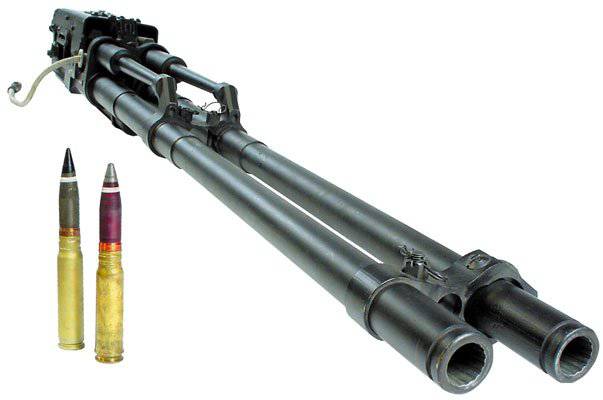
In 1965, the designers of the Tula KBP created their own version of the weapon according to the Gast scheme - GSh-23. She was equipped with various types of aircraft and helicopters. Moreover, both in the version of course weapons (MiG-23, Su-7B, etc.), and for installation on mobile rifle installations (Tu-95MS, Il-76, etc.). Interestingly, despite the lower rate of fire (up to 4 thousand rounds per minute) than that of the six-barreled GSh-6-23, the GSh-23 turned out to be one and a half times lighter - 50,5 kg versus 76.
In the late 70s, the GSH-25-30 gun, also made according to the Gast scheme, was specially designed for the Su-2 attack aircraft, which was then being created. Its two barrels give out only three thousand shots, but this is compensated by the caliber of 30 millimeters. Later, a version of the gun with longer barrels was created, designed for installation on Mi-24P helicopters.
What's next?
Next year, the Gatling system will be 150 years old. Gast's scheme is a bit younger. Unlike their predecessors - mitraliasis - these systems are actively used and no one is going to abandon them yet. At the same time, for a long time, multi-barreled systems did not have significant increases in the rate of fire. There are two main reasons for this: firstly, new materials and technologies are needed for the next increase in the rate of fire. The Americans, for example, have already had to deal with jamming of the then-existing link projectile belts. Secondly, frankly speaking, there is little point in dispersing cannons or machine guns: the density of fire will grow exclusively along with the consumption of ammunition. Based on the foregoing, it can be assumed that in the future the appearance of multi-barreled weapons will not change, but new materials and various know-how will be introduced.

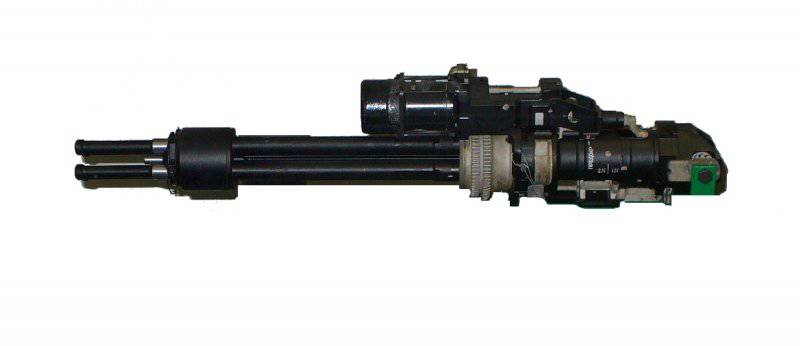
Information